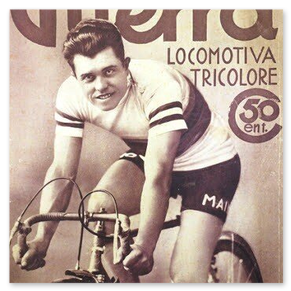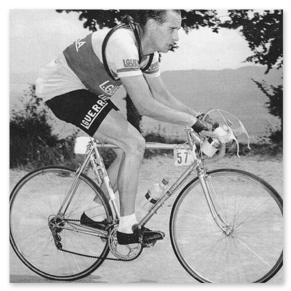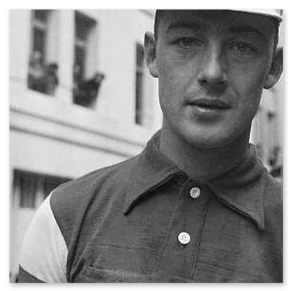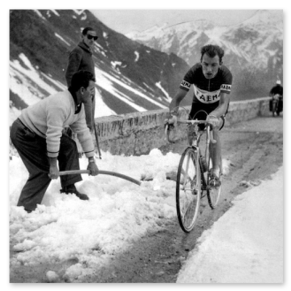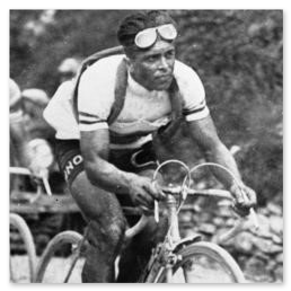Guerra
Stroria dei fratelli Guerra

I fratelli Guerra in tutto erano sei, Luigi nacque nel 1916 e fu l’unico a nascere a Lugo. La madre morì quando i figli erano ancora molto giovani e il padre fu costretto a mandare i figli nel collegio statale Villa S. Martino di Lugo, dove ebbero la possibilità di acquisire quella formazione di base, oltre al diploma statale di specializzazione. Durante gli studi Luigi Guerra oltre alla saldatura imparò anche a lavorare a mano il metallo, creando sculture in acciaio. Negli anni ’30 cominciò a lavorare presso la Cantagalli insieme a tre dei suoi fratelli. Nell’officina Cantagalli i fratelli Guerra, grazie alla specializzazione, erano tra i pochi saper saldare e verniciare telai e vennero tutti incaricati della direzione dei reparti produttivi, Luigi e il suo futuro socio alla saldatura, gli altri due alla verniciatura. Luigi Guerra partì per il servizio militare in Africa nel 1938 e torno a casa solo nel 1944. Appena tornato ricominciò subito a lavorare presso la Cantagalli e solo due anni dopo insieme al fratello aprirono la propria officina nella casa di famiglia della moglie di Luigi, nel centro di Lugo. Dieci anni dopo, con il boom economico e l’espansione del mercato della bicicletta sportiva, i fratelli Guerra si specializzarono nella costruzione di bici da corsa per amatori e professionisti.L’officina F.lli Guerra di Lugo chiuse alla fine degli anni ’70. Luigi Guerrà morì all’età di 82 anni, e fino a poco prima continuava ad usare la bicicletta.

The Guerra brothers were six in all, Luigi was born in 1916 and was the only one born in Lugo. The mother died when the children were still very young and the father was forced to send their children to the state college Villa S. Martino di Lugo, where they had the opportunity to acquire that basic training, in addition to the state specialization diploma. During his studies Luigi Guerra, in addition to welding, also learned to work metal by hand, creating steel sculptures. In the 1930s he started working at Cantagalli together with three of his brothers. In the Cantagalli workshop, the Guerra brothers, thanks to their specialization, were among the few to be able to weld and paint frames and were all in charge of the direction of the production departments, Luigi and his future partner in welding, the other two in painting. Luigi Guerra left for military service in Africa in 1938 and returned home only in 1944. As soon as he returned he immediately started working again at Cantagalli and only two years later together with his brother did they open their workshop in the family home of Luigi's wife, in center of Lugo. Ten years later, with the economic boom and the expansion of the sports bicycle market, the Guerra brothers specialized in the construction of racing bikes for amateurs and professionals.The F.lli Guerra di Lugo workshop closed in the late 1970s . Luigi Guerrà died at the age of 82, and until recently he continued to use the bicycle

Learco Guerra

Learco Guerra è stato un ciclista professionista italiano di corse su strada. Il momento più elevato della sua carriera fu la sua vittoria finale nel Giro d'Italia del 1934. Guerra nacque il 14 ottobre 1902 a San Nicolò Po, una frazione di Bagnolo San Vito in Lombardia, e ottenne il soprannome di "Locomotiva umana" per la sua resistenza nelle corse a tappe. Dopo tentativi mediocri di giocare a calcio, Guerra divenne un ciclista professionista nel 1928, a 26 anni. L'anno seguente divenne campione italiano, correndo come indipendente o semi-professionista.
Nel 1930 vinse i suoi primi campionati nazionali di corsa su strada, il primo di cinque vittorie consecutive. Lo stesso anno è arrivato secondo al Tour de France dopo che il leader del team italiano, Alfredo Binda, si era dimostrato in non buone condizioni atletiche. La gara è stata vinta dal francese André Leducq. Nel 1931 Guerra vinse quattro tappe del Giro d'Italia ma non la vittoria finale. In questo Giro, è stato il primo ciclista a indossare la maglia rosa. Lo stesso anno ha vinto il campionato del mondo di ciclismo.
Nel 1933 Guerra fu di nuovo secondo nel Tour de France, e vinse il Milan-San Remo. Nel 1934 arrivò il suo più grande successo, 10 tappe del Giro d'Italia e la classifica generale. Era anche secondo nel campionato del mondo. Guerra ha stabilito un record di vittorie in un solo anno, battuto solo negli anni '70. La sua fama fu sfruttata dal governo fascista, che approfittò del suo status eroico. Dopo essersi ritirato, ha lavorato come team manager per ciclisti come Hugo Koblet e Charly Gaul portandoli alla vittoria ( ricordiamo la vittoria di Gaul al Bondone nella tappa più dura di sempre al Giro d’italia sotto la neve). I corridori che ha diretto usarono bicilette Guerra, infatti diede il suo nome di campione per produrre e commercializzare biciclette da corsa e da turismo. La sua ultima scoperta fu il talentuoso Gianni Motta che portò dai dilettanti al professionismo. Motta vinse il Giro d’Italia nel 1966 ma Guerra ci lasciò tre anni prima non potendo vedere la più bella vittoria del suo ultimo talento.

Learco Guerra was an Italian professional road racing cyclist. The highlight of his career was his overall win in the 1934 Giro d'Italia. He was born on October 14,, 1902 in San Nicolò Po, a frazione of Bagnolo San Vito in Lombardy, gained the nickname of "Human Locomotive" for his enduring quality in plain stages. After mediocre attempts to play football, Guerra became a professional cyclist in 1928, at 26. The following year he became Italian champion, racing as an independent or semi-professional.
In 1930 he won his first Italian National Road Race Championships, the first of five straight wins. That same year he came second in the Tour de France after Italy's leader, Alfredo Binda, proved in poor form. The race was won by the Frenchman, André Leducq. In 1931 Guerra won four stages of the Giro d'Italia but not the final victory. In this Giro, he was the first rider who wore the pink jersey. The same year he won the world cycling championship.
In 1933 Guerra was again second in the Tour de France, and he won the Milan–San Remo. In 1934 came his greatest success, 10 stages of the Giro d'Italia and the general classification. He was also second in the world championship. Guerra set a record of victories in a single year that was beaten only in the 1970s. His fame was exploited by the Fascist government, which profited from his heroic status. After retirement, he worked as a team manager for riders such as Hugo Koblet and Charly Gaul. He died in Milan in 1963. After retiring from racing, he became an appreciated bicycle manufacturer, was technical commissioner of the Italian national team and subsequently one of the best sports directors in circulation. With him Hugo Koblet, the first foreigner ever, won the 1950 Giro d'Italia. With him the little Charly Gaul, who would have become "the Angel of the mountain" and had been discovered by Guerra when nobody believed that shy boy and minute he could aim for the final goal, he won the 1956 and 1959 laps. (we remember the victory of Gaul at Bondone in the toughest stage ever in the Giro d'Italia under the snow).The racers he directed used Guerra bicycles, in fact he gave his champion name to produce and market racing and touring bicycles.Motta won the Giro d'Italia in 1966, but Guerra left us three years earlier, not being able to see the best victory of his last talent.






